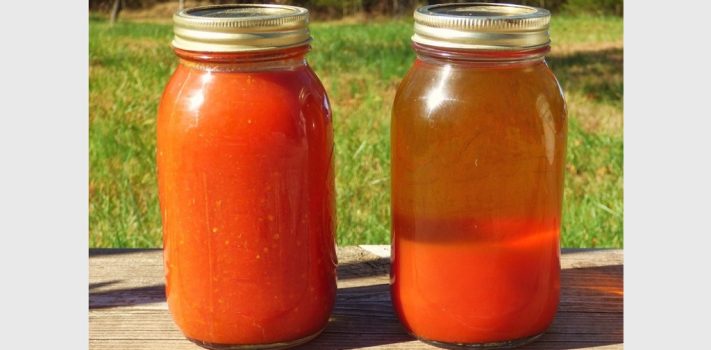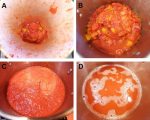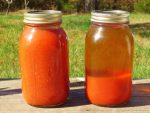I’m always on the lookout for new canning techniques and I enjoy experimenting as well. The method discussed here saves over half of the time and most of the propane is normally used to cook the tomato sauce. It’s also quick enough that it allows me to easily make three batches in a day.
With tomatoes being my largest canning crop and having doubled my production this year, this method is even more important to help me avoid spending 50+ hours canning tomatoes over a hot stove in record-breaking heat and drought this year. I should be drinking iced tea in my hammock and browsing through my SurvivalBlog archive stick, not wasting unnecessary time making tomato sauce the traditional way when there’s a quicker technique.
This article shows how to filter off the watery juice of the tomatoes before beginning to heat the puree for making sauce. With much of this liquid filtered off, the sauce is already at its prime thickness and needs only to be brought to a boil before being ladling into jars and processed in a canner. You’ll end up with the same number of quarts of tomato sauce as you normally would plus as an added bonus: that same amount of “poor-man’s” tomato juice.
Canning to Save Propane
A big concern for many of us after the SHTF will be the fact that the propane man will only be a distant memory we’ll tell our grandchildren about and they’ll marvel that a certain kind of compressed air could be used to cook our food and heat our homes. Whatever propane we have when the lights go out will have to last as long as possible by reserving it for only the most efficient uses possible such as cooking and canning. For that reason, anything that can be done to conserve propane in our home canning procedures should become standard TEOTWAWKI procedure. This canning method fits the bill.
The filtering technique shown here greatly speeds up the process and provides a thick sauce without all the boiling time on the top of the stove. Every BTU of propane will be worth its weight in MRE’s after the SHTF so this method uses much fewer BTU’s than the traditional method of boiling the sauce down to the proper consistency.
And one more huge benefit: it reduces the monotony and torture of standing for half the afternoon stirring and stirring in order to boil all that tomato puree down so it’ll be thick enough to keep your Italian mother-in-law proud of you. Just don’t tell her your secret.
Why Tomato Sauce Separates in the Jar
Many wonder why your tomato sauce separates after canning. When tomatoes are cut and then not processed quickly enough they form pectose, an enzyme which breaks down the pectin in tomato cell walls. As the walls disintegrate, the contents of the cells are released and much of it forms the liquid we see when canned tomatoes separate. But this same enzyme can work to our advantage.
I serendipitously discovered while harvesting honey from my beehives that I could use the same honey-filtering procedure to process my tomato sauce in a much more efficient way. Using this filtering method, my goal isn’t to avoid having my canning tomatoes separate but rather the opposite: I want the clear juice to separate from the tomatoes. I can then filter it out before beginning to puree the tomatoes for sauce.
To accomplish this separation, during the harvest I freeze cored, quartered tomatoes until I get enough to make a large batch at one time. As they thaw, a clear liquid separates from the meaty portion of the tomato. Aside from the pectose doing its job, the freezing process also causes cell walls to burst the same way freezing water bursts plumbing pipes. On average the ratio of the meaty portion to the watery portion is close to 1:1.
Making Sauce on Canning Day
To make sauce, I place the frozen bags of tomatoes to thaw in a large plastic tote the night before. While thawing, the separated watery juice becomes very noticeable in the bags. When the tomatoes are completely thawed, the filtering portion comes next.
For some of us, nylon paint filters are a very versatile item around the homestead and more so in the kitchen than anywhere else. They come in both one- and five-gallon sizes and with or without an elastic at the opening as seen in Photo 1. Paint filters are a flexible bag made of a fine nylon mesh, cost around a dollar each, and can be reused countless times. Among other uses, the gallon-sized filters with an elastic are perfect for covering the top of a gallon jar when making vinegar. If carcinogens concern you, check the filter label to be sure it’s nylon, not polyester. Home brewers use nylon filters. If it’s not stated on the label, melt a small corner. Nylon will form a hard gray bead while polyester forms a black bead.
There are also stainless-steel fine-mesh strainers available online. It would be worth experimenting with different mesh sizes but so far I’m enjoying less mess and the large volume of tomatoes a paint filter in a 5-gallon bucket can hold.
The Filtering Process
Photo 2 shows the steps for using a paint filter to process tomato sauce.
To begin, wash a 5-gallon filter, line a 5-gallon bucket with it and empty the entire contents of bags of thawed tomatoes into the filter (Photo 2A). When the filter is filled to your comfort level, lift it out of the bucket and hold it for 10-15 seconds to let some of the juice stop dripping, there’s no need to squeeze it, then dump the tomatoes into a large kettle (2B). I prefer to have all the filtered tomatoes in a single kettle before I start the pureeing process but you may prefer to puree them as they come out of the filter. As you’re pureeing with a blender, pour the resulting sauce into a second kettle for heating (2C). If the sauce is thick enough to form peaks, and generally it will be, a little juice will have to be added back in to prevent the sauce from bubbling like Yellowstone mud pots, making a huge mess in the process. Finally, rinse the first kettle and pour the juice from the 5-gallon bucket into it for boiling and canning (2D).
Now, instead of wasting propane boiling off water and thinking about your aching back and feet, the watery liquid has already been separated out and the thick sauce needs only to be brought to a boil before being ladled into jars for water-bath processing. With so much time saved, the process is accomplished rather quickly and several batches can be canned in the same day.
One more energy-saving benefit is that you can use the same hot water bath the sauce was processed in to process the juice, saving the time and propane to heat it up all over again. If you time it right, you can have the juice boiling in its kettle just as the sauce is coming out of the canner.
Tomato Juice
The filtered juice is poured out of the 5-gallon bucket into a kettle and boiled, then ladled into jars and processed in the water-bath canner.
The juice won’t be clear to start, it’ll be a watery red when the jars come out of the canner. By the time it cools, a loose sediment will have started to settle out and will eventually fill the lower third of the jar as seen in Photo 3. Even though the tomato juice looks dilute and watery, it’s actually quite flavorful and retains its share of the nutrients. Since it’s largely made up of what was inside the cells of the tomato, I wouldn’t be surprised if it had more nutrients than the sauce. Until I get a beefed-up version of my Little Scientist chemistry set, I’ll have to wait in suspense. Either way, all nutrients which were present in the whole tomato are still present, just in two different jars, in two different forms, and used two in different ways.
My preference is to chill the juice, shake it, and drink it straight out of the jar, especially during hot summers when I’m working outside most of the time. It’s very refreshing and tastes great. I call it V-1 juice, the poor man’s version of V-8 juice. I’ve done some research for making tomato juice but finally decided V-1 juice tastes pretty good as it is so no need to complicate things further by adding more ingredients. Hence, V-1 juice. It’s also good in also used the juice in smoothies but felt like I was wasting it when it’s so good all by itself.
Conclusion
Well, there you have it, a quick and easy way to make tomato sauce without spending a lot of time and energy boiling it down to the right consistency. You’ll get just as many quarts of sauce as you would doing it the traditional way but with the added bonus of having an equal amount of tomato juice to boot. On a 7-quart batch of tomato sauce, I can choose to make it the traditional way and boil it down 50%, letting the other 50% of the liquid boil off into the air as steam like Mom used to do, or I can filter that extra liquid off to begin with and still end up with 7 quarts of sauce, plus another 7 quarts of tomato juice. I’ll take that option any day of the week.
Today we have the choice to make our tomato sauce the traditional way or to use this time- and energy-saving filtering method. If the grid coughs up its last kilowatt next Tuesday and goes the way of the dinosaurs, this system or something similar would be the best way to go when we can no longer afford to waste a single BTU of propane. Aside from saving precious propane, it’ll also give us more time for the multitude of other time-consuming chores our labor-intensive lives will be filled with, a life of manual labor most of us can’t even imagine right now.
Give this tomato filtering a try with one batch of this year’s tomato sauce, if for no other reason than to make it easier to recall the idea if TEOTWAWKI ever becomes a reality. Stock up on both one- and five-gallon nylon paint filters, you’ll discover they have a lot of different uses around the homestead and post-SHTF.













